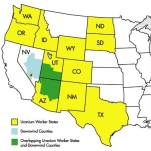Nevada Test Site Historical Foundation
- $50,000 to individuals residing or working “downwind” of the Nevada Test Site
- $75,000 for workers participating in above-ground nuclear weapons tests
- $100,000 for uranium mining and mill workers and ore transporters
Those who participated onsite in a test involving the atmospheric detonation of a nuclear device may be eligible for a payment of $75,000. A claimant must have been present above or within the official boundaries of the Nevada, Pacific, Trinity or South Atlantic Test Sites at any time during a period of atmospheric nuclear testing and must have participated during that time in the atmospheric detonation of a nuclear device. Diseases covered are leukemia (other than chronic lymphocytic leukemia), lung cancer, multiple myeloma, lymphomas (other than Hodgkin's disease), primary cancer of the thyroid, or any of the following types of cancer: male or female breast, esophagus, stomach, pharynx, small intestine, pancreas, bile ducts, gall bladder, salivary gland, urinary bladder, brain, colon, ovary, liver (except if cirrhosis or hepatitis B is indicated) or lung.
America’s Radiation Victims: The Secret Files (by Clifford T. Honicker, New York Times)
The Hanford Downwinders Litigation Information Resourse (Downwinders)
RECP Lacking Scientific Criteria
- Table of Contents
- Overview
- History
- What it Does
- Where Does the Money Go
- Controversies
- Suggested Reforms
- Comments
- Leave a comment


Kali N. Bracey was named deputy assistant attorney general of the U.S. Department of Justice Civil Division’s Torts Branch in July 2014. The appointment put her in charge of the division’s Radiation Exposure Compensation Program, which provides financial restitution to individuals who became seriously ill as a result of nuclear testing and uranium mining during the Cold War.
Bracey graduated Massachusetts’ Amherst Regional High School in 1989 and went on to Spellman College, earning her B.A. in sociology in 1993. She then attended Yale Law School, where she received her J.D. in 1996. That September, she took a year-long job as a law clerk for Judge Stephen Reinhardt of the United States Court of Appeals for the Ninth Circuit. In October 1997, she became a staff attorney at the Public Defender Service for the District of Columbia, representing indigent defendants charged with offenses ranging from misdemeanors to felonies and murder. In 2001, her final year at the service, she handled cases in the appellate division.
In February of 2002, Bracey joined the Washington, D.C., law firm of Jenner & Block, where she worked as an associate until becoming a partner in January 2007. She focused on the areas of insurance litigation, white-collar crime, entertainment and new media, and represented clients in state and federal courts throughout the U.S. in cases involving copyright, redistricting, telecommunications and product liability.
Bracey left the firm in March 2012 to join what was then a new federal agency, the Consumer Financial Protection Bureau (CFPB). She worked as senior counsel in its Office of Supervision Policy and was involved in student loan servicing, auto lending, and CFPB rulemaking. A year later, she was named the Bureau’s senior counsel and executive secretary, and then continued up the ladder to become counsel to the director and executive secretary. She held that post until her appointment at the Justice Department the following year.
Bracey and her husband, Eric Brown, have a young daughter, Zora.
-Danny Biederman

- Latest News
- D.C. Public Schools will Teach all Second-Graders to Ride a Bike
- New Rule in Germany Limits Sales of Sex-Themed E-Books to 10pm to 6am
- What Happened to the 6-Year-Old Tibetan Boy the Chinese Government Kidnapped 20 Years Ago?
- U.S. Ambassador to Turkey Photoshops his Hair Color to Mock Turkish Mayor
- Mystery Artist Calls Attention to Unfixed Potholes by Drawing Penises around Them
Nevada Test Site Historical Foundation
- $50,000 to individuals residing or working “downwind” of the Nevada Test Site
- $75,000 for workers participating in above-ground nuclear weapons tests
- $100,000 for uranium mining and mill workers and ore transporters
Those who participated onsite in a test involving the atmospheric detonation of a nuclear device may be eligible for a payment of $75,000. A claimant must have been present above or within the official boundaries of the Nevada, Pacific, Trinity or South Atlantic Test Sites at any time during a period of atmospheric nuclear testing and must have participated during that time in the atmospheric detonation of a nuclear device. Diseases covered are leukemia (other than chronic lymphocytic leukemia), lung cancer, multiple myeloma, lymphomas (other than Hodgkin's disease), primary cancer of the thyroid, or any of the following types of cancer: male or female breast, esophagus, stomach, pharynx, small intestine, pancreas, bile ducts, gall bladder, salivary gland, urinary bladder, brain, colon, ovary, liver (except if cirrhosis or hepatitis B is indicated) or lung.
America’s Radiation Victims: The Secret Files (by Clifford T. Honicker, New York Times)
The Hanford Downwinders Litigation Information Resourse (Downwinders)
RECP Lacking Scientific Criteria
Comments


Kali N. Bracey was named deputy assistant attorney general of the U.S. Department of Justice Civil Division’s Torts Branch in July 2014. The appointment put her in charge of the division’s Radiation Exposure Compensation Program, which provides financial restitution to individuals who became seriously ill as a result of nuclear testing and uranium mining during the Cold War.
Bracey graduated Massachusetts’ Amherst Regional High School in 1989 and went on to Spellman College, earning her B.A. in sociology in 1993. She then attended Yale Law School, where she received her J.D. in 1996. That September, she took a year-long job as a law clerk for Judge Stephen Reinhardt of the United States Court of Appeals for the Ninth Circuit. In October 1997, she became a staff attorney at the Public Defender Service for the District of Columbia, representing indigent defendants charged with offenses ranging from misdemeanors to felonies and murder. In 2001, her final year at the service, she handled cases in the appellate division.
In February of 2002, Bracey joined the Washington, D.C., law firm of Jenner & Block, where she worked as an associate until becoming a partner in January 2007. She focused on the areas of insurance litigation, white-collar crime, entertainment and new media, and represented clients in state and federal courts throughout the U.S. in cases involving copyright, redistricting, telecommunications and product liability.
Bracey left the firm in March 2012 to join what was then a new federal agency, the Consumer Financial Protection Bureau (CFPB). She worked as senior counsel in its Office of Supervision Policy and was involved in student loan servicing, auto lending, and CFPB rulemaking. A year later, she was named the Bureau’s senior counsel and executive secretary, and then continued up the ladder to become counsel to the director and executive secretary. She held that post until her appointment at the Justice Department the following year.
Bracey and her husband, Eric Brown, have a young daughter, Zora.
-Danny Biederman

- Latest News
- D.C. Public Schools will Teach all Second-Graders to Ride a Bike
- New Rule in Germany Limits Sales of Sex-Themed E-Books to 10pm to 6am
- What Happened to the 6-Year-Old Tibetan Boy the Chinese Government Kidnapped 20 Years Ago?
- U.S. Ambassador to Turkey Photoshops his Hair Color to Mock Turkish Mayor
- Mystery Artist Calls Attention to Unfixed Potholes by Drawing Penises around Them





Comments